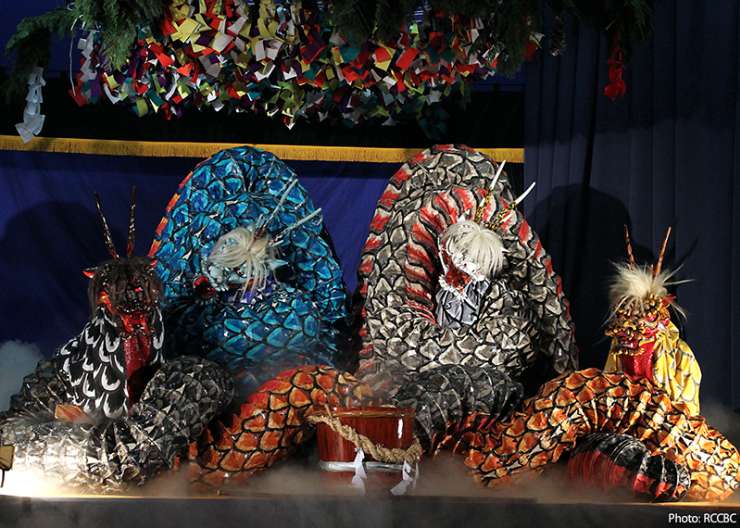
Traditional Japanese theater is an acquired taste. While no-one can doubt the cultural importance of Noh and Kabuki, to the uninitiated, they can feel more like a test of endurance than entertainment. The folk art of Kagura found in parts of western Japan, notably the Iwami area of Shimane Prefecture and northern Hiroshima prefecture, on the other hand, is a completely different experience altogether.
The kanji characters that make up the term ka-gura literally mean “dances for the gods” and many accounts trace the tradition to an episode almost as old as the islands of Japan themselves. The sun goddess, Amaterasu, was tempted out of self-imposed confinement in a cave by means of a somewhat lurid dance, thus restoring light to the world. Ritual Kagura is performed at Shinto shrines all over Japan and is generally a fairly sombre affair. In Western Japan, however, the art has evolved into a far more performative and crowd-pleasing form.

The tempo set by the musicians is quick and the rhythm infectious, the painstakingly hand-embroidered costumes, some of which weigh over 20kg, are stunning, and then there are the battles. The portrayal of Japan’s indigenous gods being forbidden by the US occupation forces in the years after the war, many of the most popular Kagura pieces performed today are adaptations of the folktales and legends found in the Kabuki and Noh canon. They are tales of heroes doing battle against vengeful sorceresses, “earth spiders”, flying chimera and eight-headed serpents. Good always triumphs in the end, but not after some spectacular fight scenes which feature dry ice, fireworks, shooting webs and blood red streamers.

Kagura is best enjoyed at a local shrine, surrounded by locals cheering on their heroes and applauding the lightning-fast costume changes and particularly well-executed moves, preferably when a bottle of sake is being passed around. If you can’t track down a festival, don’t worry, there are now several opportunities to enjoy Hiroshima Kagura in the city center on a weekly basis.
Between April and December, visitors can enjoy two 45 minute Kagura performances every Wednesday night at Hiroshima Prefectural Citizens’ Culture Hall. The shows are followed by an opportunity to take photos with the performers and try on the costumes and masks.
Less regular, and usually on weekends, is the An Evening of Kagura - English Kagura Experience. The English Kagura Experience has one 45 minute performance with very helpful English subtitles on a monitor to help you keep up with what’s happening on stage and a chance to ask the performers questions through an interpreter as well as take souvenir photos.
The English Kagura venue changes for time to time, so it’s advisable to check the website www.hiroshima-kagura.com for dates and locations. Whichever you choose, catching a Kagura performance is a highlight of any trip to Hiroshima.
Hiroshima Kagura
Address: Hiroshima Rijo Kaikan 1-5-3 Otemachi, Naka-ku, Hiroshima-shi, Hiroshima
Website:
http://www.hiroshima-kagura.com/
http://www.rccbc.co.jp/event/kagura/en/
https://www.facebook.com/EnglishKagura/
Phone: 082-245-2311(Japanese only. Messaging through the English Facebook Page recommended.)
Fee: 1,000 yen (GST inclusive)
Running time: 45 minutes
Information about transport passes:
Visit Hiroshima Tourist Pass
http://www.hiroden.co.jp/en/e-vhtp.html
JR-WEST RAIL PASS
https://www.westjr.co.jp/global/en/ticket/pass/
*Information is correct as of January 2019.
























































